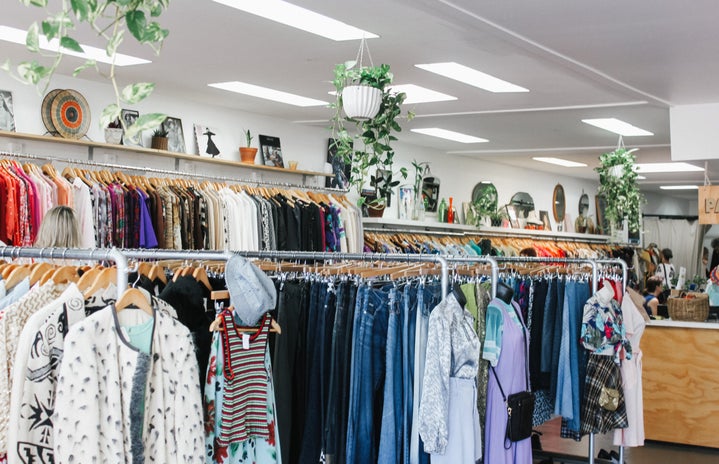Every day, fast fashion continues to be a growing problem in the mass-market business world. Fast Fashion is a manufacturing method that prioritizes fast production. Fast fashion creates cheaply-made clothing that can be sold at reasonable prices, at the cost of those who make it as well as environmental degradation. Due to the low quality of many “trendy” big-name fashion businesses, clothing items will not last as long, creating a greater environmental issue. Listed below are 10 sustainable alternatives to practice in order to avoid fast fashion.
- Shopping Second-Hand
-
Buying second-hand is a great sustainable alternative, because it avoids large clothing corporations that participate in fast fashion. Shopping second-hand not only helps the environment, but can help small business too. Going thrifting, shopping at vintage stores, or using second-hand online shopping apps are all great alternatives. Apps like Depop and Poshmark are great apps to use for shopping and selling second-hand.
- Finding Ethical and Eco-Friendly Brands
-
While many larger clothing corporations fall to fast fashion, there are still sustainable clothing brands out there. Shopping from these ethical and eco-friendly brands is a great alternative, especially for someone who still wants new pieces while being sustainable. When clothing is made ethically, the planet and people who work for this business are being supported. Ethical clothing brands aim to help reverse the environmental impact that clothing has made. Some eco-friendly brands to shop from are Patagonia, Reformation, and Alternative Apparel. You can also use this The Fig, which was created by a Cal Poly alumni, to find sustainable fashion brands.
- Alter Old Clothing Into New Pieces
-
This alternative is also known as upcycling, which is a great way to mend or transform old clothing pieces into a new wardrobe. Upcycling is a great way to extend the lifespan of your closet and minimize your impact on the environment. Common ways to upcycle include mending or sewing clothing pieces, or adding fun new details through embroidering or patches.
- Donate Unwanted Clothes
-
Instead of throwing out unwanted pieces that are still in good condition, consider donating your clothes. Throwing out clothes will lead them to be sent to landfills to decompose which can negatively impact the environment. You can donate your clothing to friends, family, shelters, charitable organizations, thrift stores, and more. Thrift stories also often donate their proceeds to organizations in need. Good Will is also a great place to donate clothing. Donating your pieces is also a great way to give to others who will bring love back into the clothes.
- Take Better Care of Your Clothes
-
Taking better care of your clothing pieces will extend their life and reduce your environmental footprint. Usually clothing will have the best way to wash and take care of them on the tags, or you can ask the retailer the best way to take care of the piece. Making sure your clothes last longer will also prevent you from constantly having to buy new pieces, which will reduce your participation in fast fashion. This is a simple, yet effective way to be more sustainable with your clothing.
- Shop at Local Small Businesses
-
Many clothing pieces, especially those that participate in fast fashion, are made internationally, so shopping at local businesses can ensure that their pieces are made locally and therefore have a smaller impact on the environment. When clothing pieces are produced in places all across the world and then transported to the larger cooperation, the carbon footprint of these products is greatly increased. Shopping locally is also a great way to support the community and those who make these clothing pieces directly.
- Embrace Vintage
-
When shopping, many will try to find the newest and trendiest items, but vintage pieces can also be gems. Embracing vintage is a great way to make your wardrobe unique and fun. Whether your vintage finds come from second-hand shopping or are passed down to you, try embracing the one-of-a-kind element of these pieces.
These alternatives are just a few ways to mitigate your environmental impact. Whether you try all these tips or just one, you can be a part of reducing fast fashion and moving towards a more ethical and eco-friendly clothing world.


